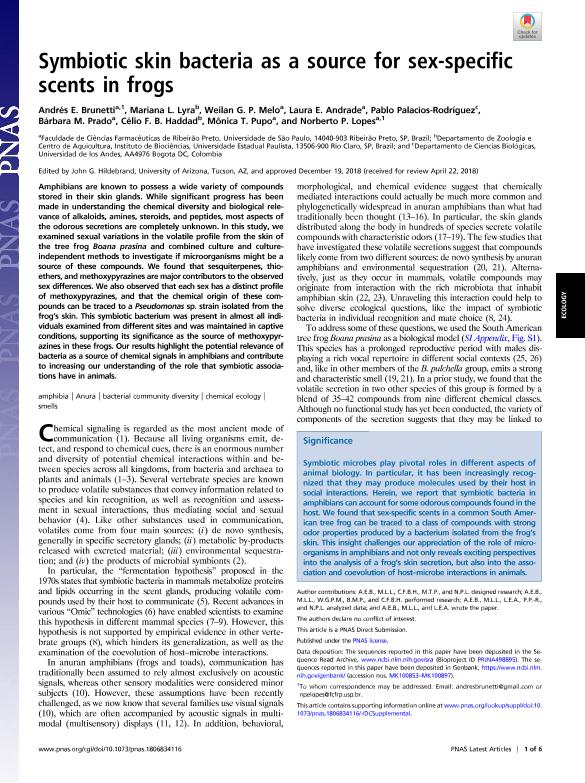Artículo
Symbiotic skin bacteria as a source for sex-specific scents in frogs
Brunetti, Andrés Eduardo ; Lucio Lyra, Mariana
; Lucio Lyra, Mariana ; Melo, Weilan G. P.; Andrade, Laura Elena; Palacios Rodríguez, Pablo; Prado, Bárbara M.; Baptista Haddad, Célio Fernando; Tallarico Pupo, Monica; Peporine Lopes, Norberto
; Melo, Weilan G. P.; Andrade, Laura Elena; Palacios Rodríguez, Pablo; Prado, Bárbara M.; Baptista Haddad, Célio Fernando; Tallarico Pupo, Monica; Peporine Lopes, Norberto
 ; Lucio Lyra, Mariana
; Lucio Lyra, Mariana ; Melo, Weilan G. P.; Andrade, Laura Elena; Palacios Rodríguez, Pablo; Prado, Bárbara M.; Baptista Haddad, Célio Fernando; Tallarico Pupo, Monica; Peporine Lopes, Norberto
; Melo, Weilan G. P.; Andrade, Laura Elena; Palacios Rodríguez, Pablo; Prado, Bárbara M.; Baptista Haddad, Célio Fernando; Tallarico Pupo, Monica; Peporine Lopes, Norberto
Fecha de publicación:
02/2019
Editorial:
National Academy of Sciences
Revista:
Proceedings of the National Academy of Sciences of The United States of America
ISSN:
0027-8424
e-ISSN:
1091-6490
Idioma:
Inglés
Tipo de recurso:
Artículo publicado
Clasificación temática:
Resumen
Amphibians are known to possess a wide variety of compounds stored in their skin glands. While significant progress has been made in understanding the chemical diversity and biological relevance of alkaloids, amines, steroids, and peptides, most aspects of the odorous secretions are completely unknown. In this study, we examined sexual variations in the volatile profile from the skin of the tree frog Boana prasina and combined culture and culture-independent methods to investigate if microorganisms might be a source of these compounds. We found that sesquiterpenes, thioethers, and methoxypyrazines are major contributors to the observed sex differences. We also observed that each sex has a distinct profile of methoxypyrazines, and that the chemical origin of these compounds can be traced to a Pseudomonas sp. strain isolated from the frog´s skin. This symbiotic bacterium was present in almost all individuals examined from different sites and was maintained in captive conditions, supporting its significance as the source of methoxypyrazines in these frogs. Our results highlight the potential relevance of bacteria as a source of chemical signals in amphibians and contribute to increasing our understanding of the role that symbiotic associations have in animals.
Palabras clave:
AMPHIBIA
,
ANURA
,
BACTERIAL COMMUNITY DIVERSITY
,
CHEMICAL ECOLOGY
,
SMELLS
Archivos asociados
Licencia
Identificadores
Colecciones
Articulos(IBS)
Articulos de INSTITUTO DE BIOLOGIA SUBTROPICAL
Articulos de INSTITUTO DE BIOLOGIA SUBTROPICAL
Citación
Brunetti, Andrés Eduardo; Lucio Lyra, Mariana; Melo, Weilan G. P.; Andrade, Laura Elena; Palacios Rodríguez, Pablo; et al.; Symbiotic skin bacteria as a source for sex-specific scents in frogs; National Academy of Sciences; Proceedings of the National Academy of Sciences of The United States of America; 116; 6; 2-2019; 2124-2129
Compartir
Altmétricas



